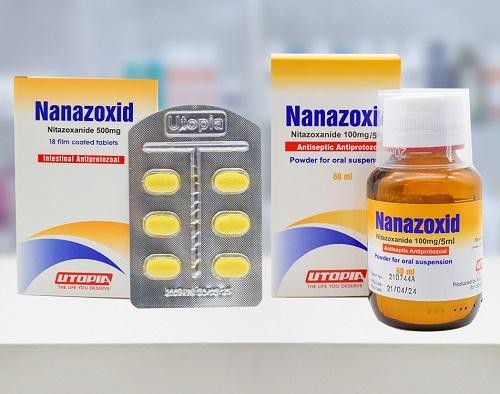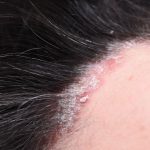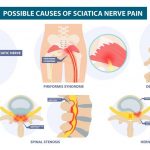
Contents
nitazoxanide
Nitazoxanide is an FDA-approved antiparasitic medication for treating diarrheal diseases in adults and children caused by microscopic protozoan parasites, such as Giardia lamblia or Cryptosporidium parvum. Nitazoxanide belongs to the thiazolides class of medication and has activity against a wide range of parasites. It is also being studied for use in amebiasis and infections caused by various other protozoa, parasitic worms, aerobic and anaerobic bacteria.
G. lamblia and C. parvum are intestinal parasites transmitted when swallowed after contact with contaminated water, food, or surfaces. The parasites multiply inside the intestines, living freely or attaching to the intestinal walls and absorbing nutrients from the infected person, causing diarrhea. The parasites are then passed in the stools in an infective stage and can contaminate soil and water in unhygienic conditions. They are protected by an outer shell called a cyst and can survive for long periods in water and soil.
Nitazoxanide inhibits parasitic activity by disrupting energy pathways essential for survival, growth, and proliferation. It targets an enzyme, pyruvate ferredoxin oxidoreductase (PFOR), which is essential for anaerobic energy metabolism in the parasites. Nitazoxanide is not effective for treating diarrhea caused by C. parvum in patients infected with HIV and immunodeficient patients.
Warnings
- Do not use nitazoxanide in patients with hypersensitivity to any component of the formulation.
- Caution should be exercised when using nitazoxanide in patients with impaired kidney or liver function.
- Avoid concurrent use with warfarin, a blood-thinning drug.
Side effects of nitazoxanide
Common side effects:
- Abdominal pain
- Nausea
- Vomiting
- Diarrhea
- Headache
- Abnormal urine color (chromaturia)
Less common side effects:
- Increase in creatinine
- Increase in liver enzyme ALT
- Gas (flatulence)
- Increase in appetite
- Loss of appetite (anorexia)
- Gastroesophageal reflux disease (GERD)
- Excessive sweating (diaphoresis)
- Eye discoloration (pale yellow)
- Ringing in the ears (tinnitus)
- Enlargement of salivary glands
- Infection
- Fever
- Feeling ill (malaise)
- Dizziness
- Shortness of breath
- Rash
- Hives (urticaria)
- Itching (pruritus)
Seek immediate medical help if you experience any of the following symptoms or serious side effects:
- Serious heart symptoms: fast or pounding heartbeats, fluttering in your chest, shortness of breath, sudden dizziness
- Severe headache, confusion, slurred speech, severe weakness, vomiting, loss of coordination, unsteadiness
- Severe nervous system reaction: very stiff muscles, high fever, sweating, confusion, fast or uneven heartbeats, tremors, feeling like you might pass out
- Serious eye symptoms: blurred vision, tunnel vision, eye pain or swelling, halos around lights
This is not a complete list of all side effects or adverse reactions. Contact your doctor for medical advice about serious side effects or adverse reactions. You can also report side effects or health problems to the FDA at 1-800-FDA-1088.
Dosages of nitazoxanide
Tablet
Oral suspension
Adult and Pediatric:
Diarrhea Caused by Cryptosporidium Parvum or Giardia Lamblia
- Children below 1 year: Safety and efficacy not established
- Children 1-3 years: 5 mL (100 mg) orally once every 12 hours for 3 days
- Children 4-11 years: 10 mL (200 mg) orally once every 12 hours for 3 days
- Children 12 years or above and adults: 500 mg orally once every 12 hours for days
Dosing considerations
- A single tablet of nitazoxanide contains more than the recommended amount for pediatric patients 11 years or younger. Therefore, tablets should not be given to pediatric patients 11 years of age or younger.
Overdose
Information about nitazoxanide overdose is limited. Single oral dosages of up to 4000 mg in healthy adults did not cause significant adverse effects. There is no specific antidote for nitazoxanide overdose. Overdose may be treated with symptomatic and supportive treatment, including gastric lavage if administered early enough.
Drug interactions with nitazoxanide
Inform your doctor about all medications you are currently taking for possible drug interactions. Do not begin or discontinue any medication without your doctor’s recommendation.
- Nitazoxanide has no known severe interactions with other drugs.
- Severe interactions include: axicabtagene ciloleucel, baricitinib, brexucabtagene autoleucel, ciltacabtagene autoleucel, idecabtagene vicleucel, lisocabtagene maraleucel, phenytoin, tisagenlecleucel, valproic acid
- Other interactions include: acetazolamide, acitretin, aspirin, bumetanide, chlorthalidone, cisplatin, clindamycin, glipizide, glyburide, tacrolimus, vincristine
- And also: dicloxacillin, diphenhydramine, fenoprofen, indomethacin, meclofenamate, mefenamic acid, naproxen, ospemifene, piroxicam, spironolactone, sulfamethoxazole, sulindac, tolbutamide, tolmetin
- This is not a complete list of all possible interactions or adverse effects. For more information, visit the RxList Drug Interaction Checker.
- Always inform your doctor, pharmacist, or healthcare provider about all prescription and over-the-counter medications you use, including the dosage for each, and keep a list for reference.
Pregnancy and breastfeeding
- Animal reproductive studies did not show evidence of fetal harm with nitazoxanide use during pregnancy. However, there are no data on its use in pregnant women. Use with caution.
- No information is available on nitazoxanide’s presence in breast milk or its effects on milk production and the breastfed infant. The decision to breastfeed should consider the nursing mother’s clinical need for nitazoxanide, the health and developmental benefits of breastfeeding, and the risks to the breastfed infant from exposure to the drug or the mother’s underlying condition.
Other important information about nitazoxanide
- Take nitazoxanide exactly as directed, with food.
- Contact your physician immediately if you experience hypersensitivity reactions.
- Store the medication out of reach of children.
- In case of overdose, seek medical help or contact Poison Control.
Summary
Nitazoxanide is an FDA-approved antiparasitic medication for treating diarrheal diseases caused by microscopic protozoan parasites, Giardia lamblia or Cryptosporidium parvum. It belongs to the thiazolides class of medication. Common side effects include abdominal pain, nausea, vomiting, diarrhea, headache, and abnormal urine color (chromaturia).


